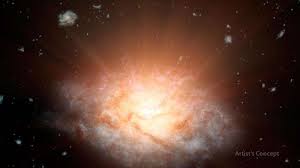
黑洞点亮星系
Frenzy-Feeding Black Hole Makes Galaxy Most Luminous
黑洞点亮星系
A galaxy 12.5 billion light-years away gives off the light of 300 trillion suns, because its feeding black hole produces enough heat to set the whole galaxy's dust glowing. Lee Billings reports
一个距离我们125亿光年的星系的亮度竟然达到了300万亿个太阳亮度的总和,而这些能量均来自于其中心的超级黑洞。
撰文/播音 李·比林斯(Lee Billings)
翻译 李轩
Astronomers have discovered the most luminous galaxy ever found, shining with the equivalence of 300 trillion suns from the far side of the visible universe. But almost all of that light is being produced by the galaxy’s central supermassive black hole—not by its stars. The enlightening finding is in The Astrophysical Journal. [Chao-Wei Tsai et al,The Most Luminous Galaxies Discovered by WISE]
天文学家发现了迄今为止最亮的星系,它位于可见宇宙的边缘,亮度与300万亿个太阳相当。但这么高的亮度几乎均来源于星系中心的超大质量黑洞,而不是星系中的恒星。这个惊人的发现发表在了《天体物理期刊》( The Astrophysical Journal)上。
Black holes are black because light itself cannot escape once falling in. But a feeding black hole is surrounded by a whirling, white-hot disk of glowing debris—material heated to millions of degrees as it spirals down to oblivion. The black hole in this faraway galaxy is on a feeding frenzy. The activity produces enough light to warm up most of the galaxy’s dust—which gives the whole galaxy an infrared glow that we can detect from more than 12.5 billion light-years away.
黑洞之所以是“黑”的,是因为光线一但落入其中就无法再次逃脱。但是一个正在吞噬物质的黑洞往往周围会包围着一个旋转的处于白热状态的发光物质盘,这里的物质在落入黑洞湮没的过程中,会被加热至上百万度。这个遥远星系的中心黑洞正是这样一个正在狼吞虎咽的狂暴黑洞。“进食”过程产生了足够多的光,以至于整个星系的尘埃都被照亮了,从而使我们即使距离他125亿光年,也可以通过红外观测看到它。
Considering we are seeing this giant black hole’s activity from a time when the universe was only a tenth of its present age, astronomers are puzzled about how it could’ve grown so big so fast. A young, hungry black hole usually takes an occasional break from feeding—its glowing debris disk can get so intense it pushes incoming material further away. Think of a baby burping mid-meal.
想像一下,我们看到的这个巨大黑洞来自于处于目前年龄十分之一的宇宙初期,天文学家很不解这个黑洞怎么会这么快就长得如此巨大。一个年轻而饥饿的黑洞通常会在吞食过程偶尔小憩一下,这时灼热的物质盘的密度会变得非常大,从而会把不断聚拢过来的物质向外推,就像婴儿在吃午饭时偶尔会打嗝。
But this particular galaxy’s black hole seems to have circumvented this limitation—if it’s burping, the burps seem to be few and far between.
但这个特别星系的黑洞似乎打破了这种常规,即使它会打嗝,嗝之间的间隔也会非常非常的大。
One theory is that it must be spinning very slowly—the slower a black hole spins, the weaker its repulsive burps may be, and the longer it can gorge uninterrupted. Study co-author Andrew Blain of the University of Leicester says that a slow spin may be how this black hole has sustained its binge, which he calls the equivalent of “winning a hot-dog-eating contest lasting hundreds of millions of years.” And if there’s any mustard with those dogs, rest assured: it’s hot.
一种理论认为它一定在缓慢地旋转,黑洞转的越慢,它向外打的嗝就会越少,它一次性进食的时间就会越长。理论的合作者——莱斯特大学的安德鲁?布兰说,缓慢的转动可能正是黑洞持续疯狂的原因,他将这个现象称为是“进行了一个持续千百万年的吃热狗竞赛”,如果这些热狗中没有芥末,它将会一直吃下去。
未经书面许可任何人不得复制或镜像
京ICP备11000850号-1
 京公网安备11010502039775号
京公网安备11010502039775号 信息网络传播视听节目许可证0111611号
国家科技基础条件平台

















